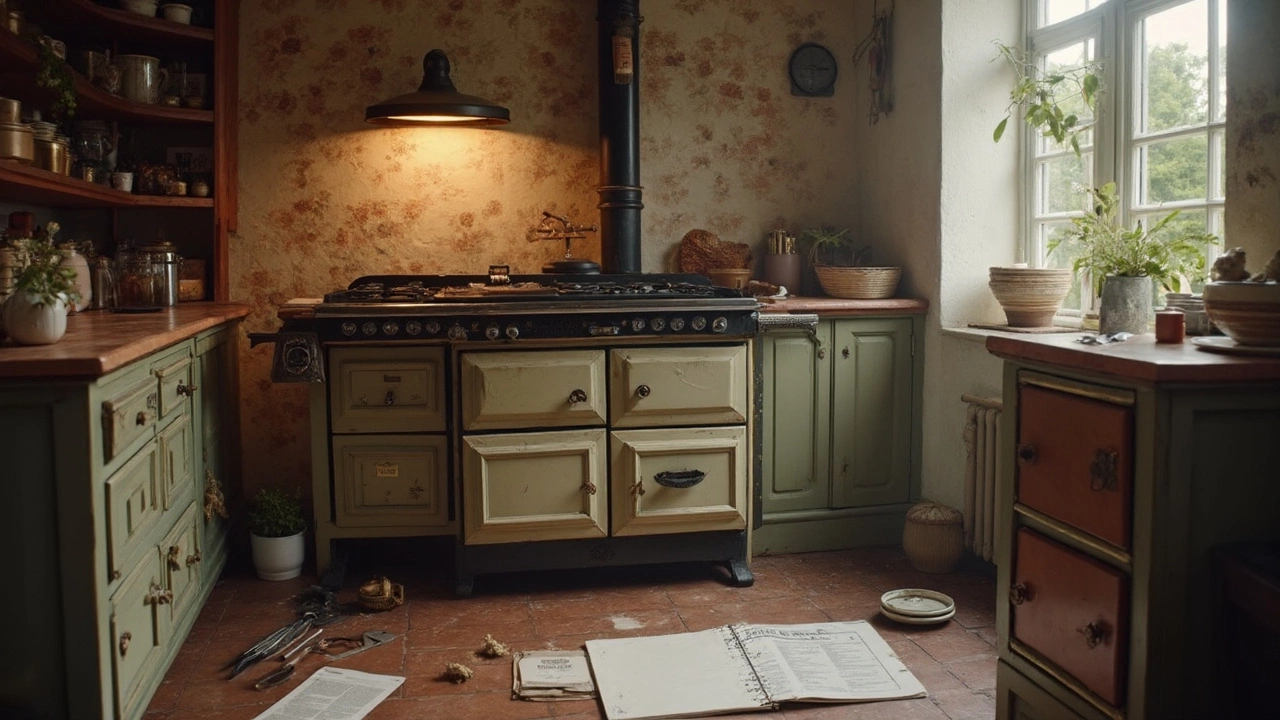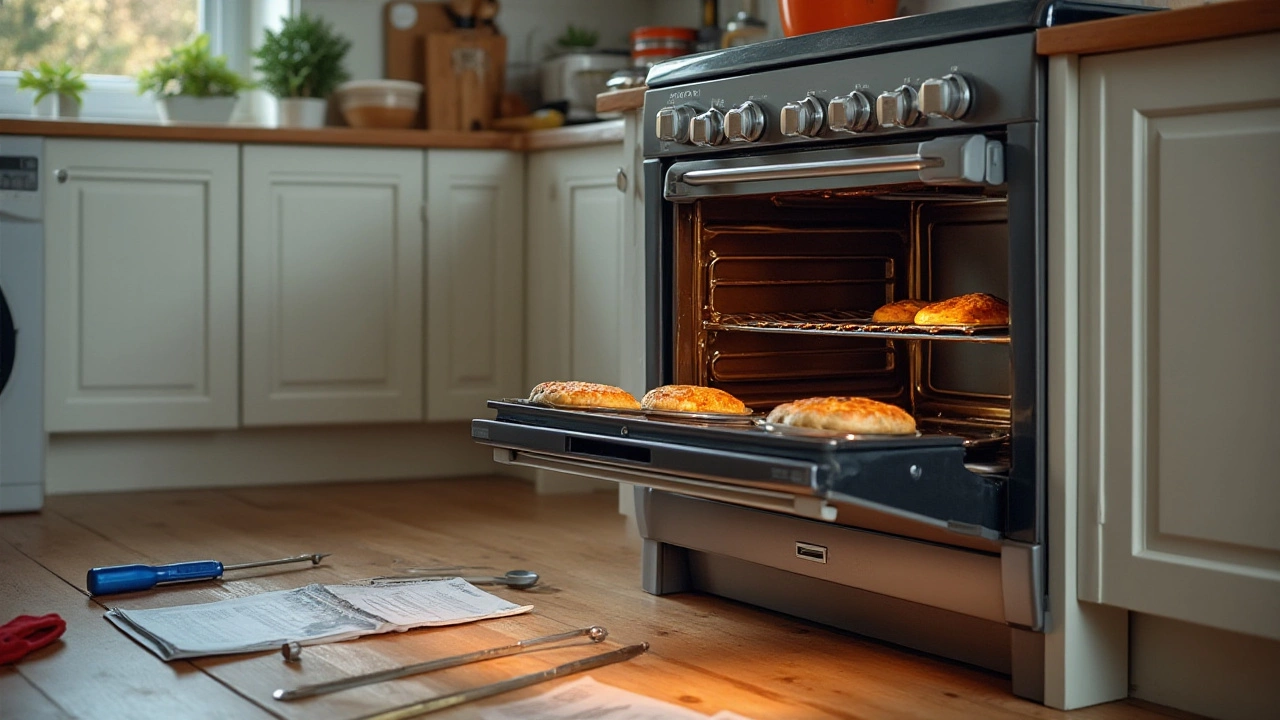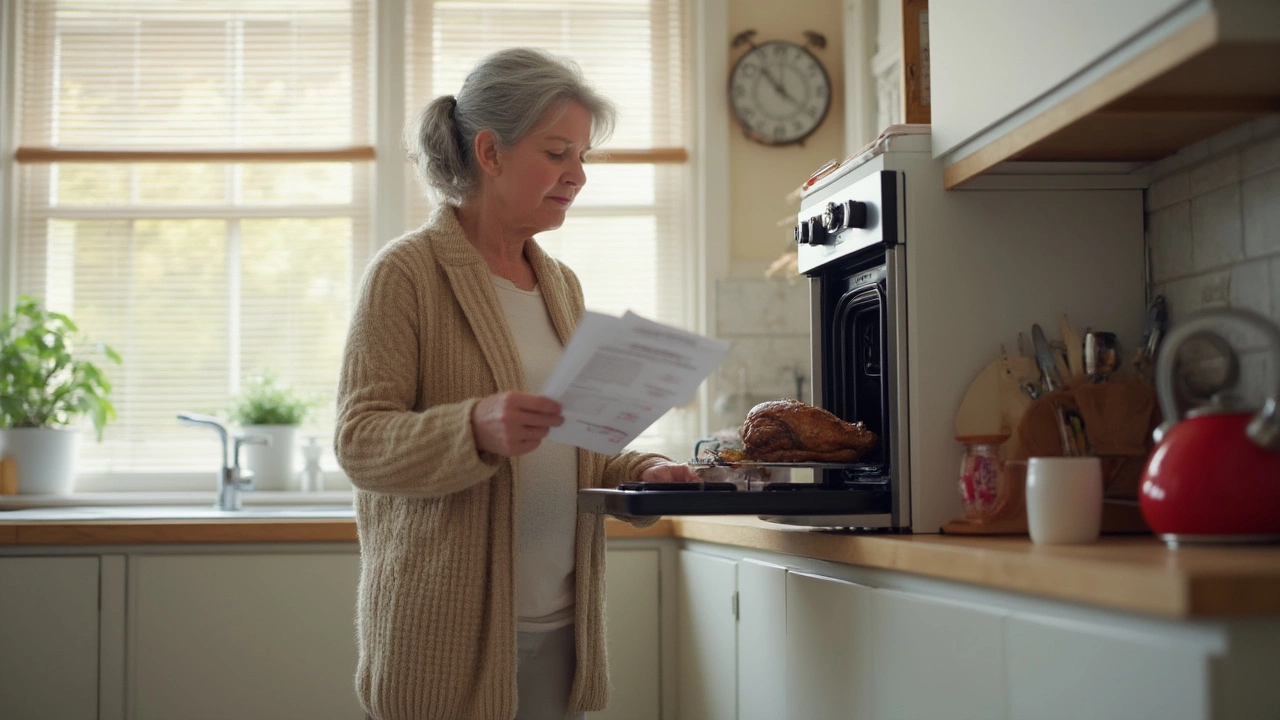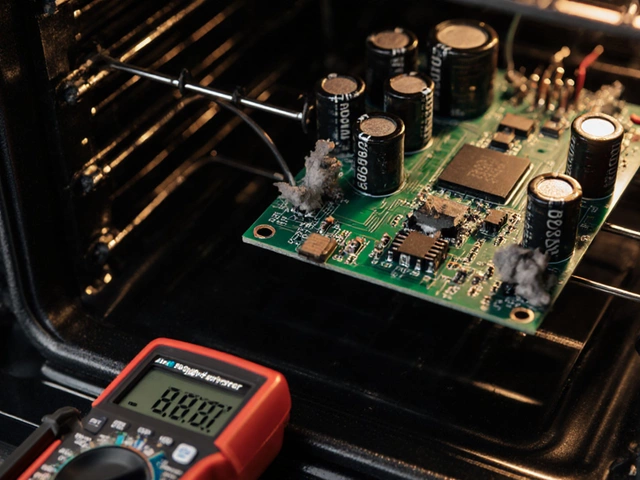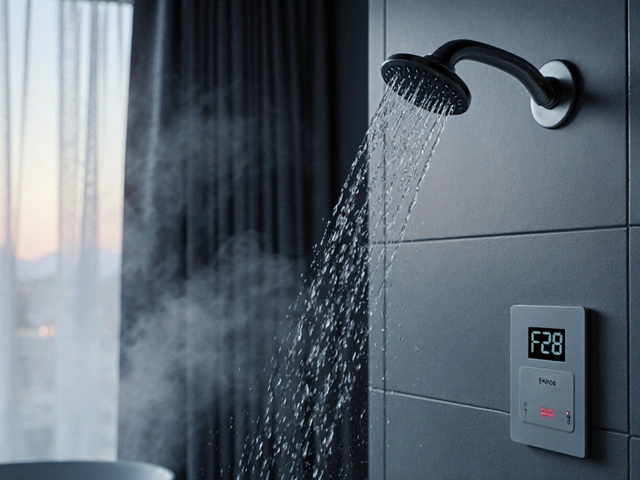So, you've got this 10-year-old oven that's been through thick and thin with you. Baked a thousand dishes, roasted countless turkeys. But now the question looms: should you keep it running with a fix, or is it time to part ways?
Well, let's start by checking if your oven is really crying for help. Look out for issues like uneven cooking, weird noises, or a door that doesn't seal properly. These are strong indicators that something's not quite right.
Next up, the costs. Sometimes the repair bill can be shockingly close to the price of a new oven. If a few repairs could total more than half the cost of a new model, it might not be worth it. A good rule of thumb is the '50% rule'—if repairs cost more than 50% of a new appliance, replacement might be best.
- Signs Your Oven Needs Attention
- Evaluating Repair Costs
- Considering Energy Efficiency
- Technology Advancements Over a Decade
- DIY Fixes vs Professional Help
- When It's Time to Say Goodbye
Signs Your Oven Needs Attention
Your trusty oven might not be as in-your-face as other appliances, but it does have ways of letting you know when it's not happy. Spotting these signs early can save you a heap of trouble—and money—down the track. So, what should you be looking for?
Uneven Cooking
If your meals are turning out burnt on one side and undercooked on the other, there's a big chance that your oven's heating elements are uneven. This is a classic sign that your old oven might need some TLC.
Noises
An oven shouldn't sound like it's getting ready for take-off. Strange noises like banging or rattling could mean parts are loose or wearing out, especially if your appliance is reaching the ten-year mark.
Fluctuating Temperatures
If your old oven's temperature can't seem to make up its mind, that's a red flag. A wonky thermostat can lead to cooking disasters and could be dangerous if left unchecked.
Perennial Pre-Heating
If your oven seems to take forever to preheat these days, you might be dealing with a faulty heating element. This can not only zap time but also energy, making your bills skyrocket.
Door Issues
A door that won't close properly isn't just annoying; it could be a problem with the hinges, seal, or even the frame itself. This affects energy efficiency and could ruin what’s cooking inside.
Smoke or Burning Smells
If every cooking session fills your kitchen with smoke or a burning odor, there might be food debris or grease built up, or it could be faulty wiring. Ignoring this could be risky.
Table: Average Lifespan of Oven Parts
| Oven Part | Average Lifespan (Years) |
|---|---|
| Heating Element | 8-12 |
| Thermostat | 10-15 |
| Hinges & Door Seal | 8-12 |
Recognizing these signs early can be your ticket to avoiding a surprise breakdown when you least expect it. So give your oven a little attention now to save a whole lot of hassle later.
Evaluating Repair Costs
So you're staring down that repair bill, wondering if it's really worth it. Let's break down how to evaluate those repair costs for your trusty 10-year-old oven. Knowing when to mend an appliance and when to move on can save you big bucks.
Getting a Repair Estimate
First off, you need an estimate from a qualified technician. Contact a local appliance repair service, and they should provide you with a ballpark figure. It'll vary depending on the issue—anything from a faulty element to a busted thermostat can impact the cost.
A typical oven repair might range from $150 to $300, depending on the complexity of the fix. However, if multiple components are on the blink, costs can rise quickly.
Cost vs. Benefit
Weigh the repair costs against the age and condition of your appliance. With a 10-year-old oven, major repairs may not make financial sense, especially if it's near the end of its expected lifespan (which is typically 10-15 years).
Here's a quick guide:
- If repairs are less than 30% of a new model's price, go ahead and fix it.
- If repairs are between 30%-50%, carefully consider your options.
- If it's over 50%, you might want to shop for a new oven.
Hidden Costs to Consider
Don't forget about the potential hidden costs of using an older appliance. An aging oven might be less energy-efficient, hiking up your electricity bill. Plus, frequent repairs can lead to a lot of hassle and downtime.
| Repair Cost Range | Recommended Action |
|---|---|
| < 30% of new oven price | Repair |
| 30%-50% of new oven price | Evaluate carefully |
| > 50% of new oven price | Consider replacement |
In the end, evaluating repair costs is about balancing short-term expenses and long-term savings. With this info, tackling that looming repair bill should be a bit less intimidating.
Considering Energy Efficiency
When you're dealing with a 10-year-old oven, energy efficiency is a big deal. Older models tend to gnaw on power like there's no tomorrow, hitting you with higher electricity bills. Newer appliances, on the other hand, are made to be much more eco-friendly and can save you a good chunk of money in the long-run.
Here's a solid fact: ovens made more than a decade ago usually have less efficient components, which means they pull more energy to do the same tasks modern units handle with ease. Upgrading to a newer oven could potentially reduce your energy consumption by around 20 to 30%.
Comparing Old vs New Models
If you're fiddling with an older oven, it's likely lacking features like advanced insulation, improved heating elements, or smart control systems. Try this: check your energy bills over the past year. If they're creeping up and there's no other culprit, your oven might be to blame.
| Feature | Old Models | New Models |
|---|---|---|
| Energy Consumption | High | Lower by 20-30% |
| Smart Controls | No | Yes |
| Insulation | Basic | Advanced |
Additionally, modern appliances often come with energy-efficient ratings that help you make a smarter choice. The U.S. Department of Energy suggests looking for appliances with the ENERGY STAR label, which are tested and ranked as top performers in efficiency.
It's easy to brush off energy savings as trivial, but when you add up the costs over several years, the math makes it clear. Investing in a more efficient model may mean spending more upfront, but the savings on your energy bill can be substantial, not to mention kinder to the environment.
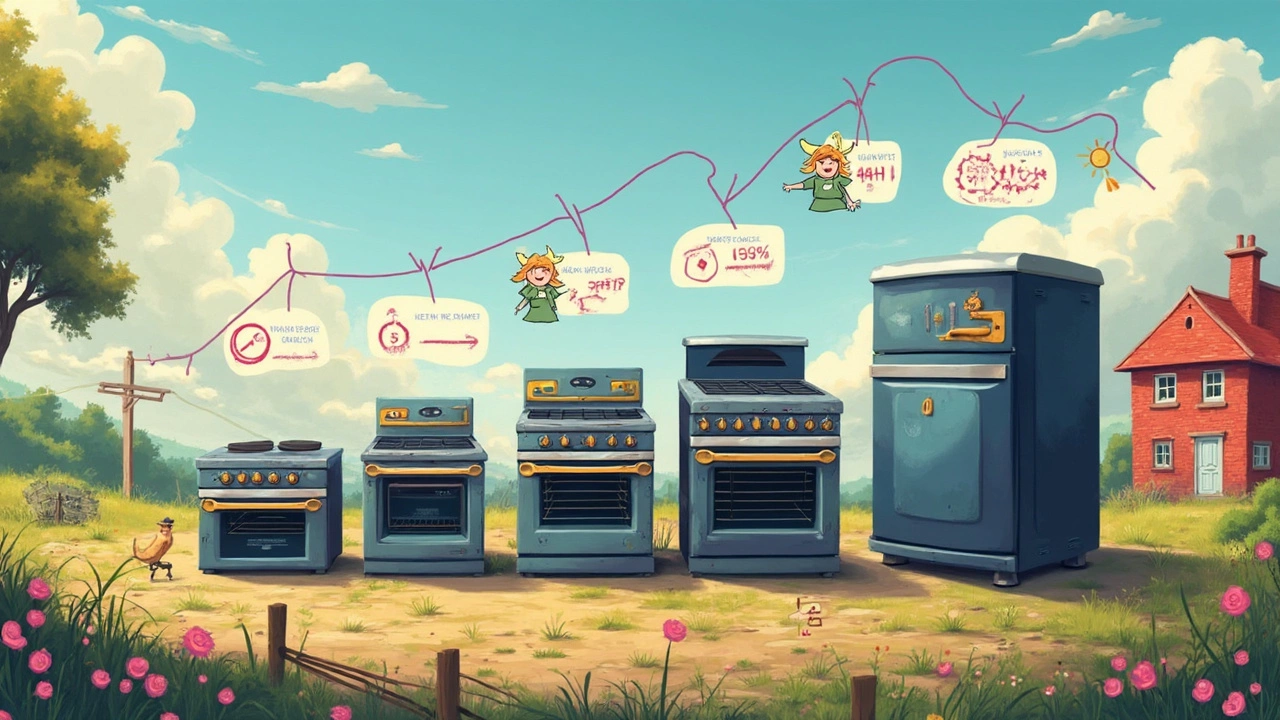
Technology Advancements Over a Decade
Over the last ten years, the world of ovens has seen some pretty nifty upgrades. If you've been loyal to your trusted 10-year-old appliance, it's worth understanding what modern options are out there. You might be surprised by what you've been missing!
Smart Ovens
Yes, even ovens have gone digital! Smart ovens are now a common feature in households, coming with Wi-Fi connectivity and apps that let you control your oven from your phone. This means you can preheat the oven on your way home or turn it off if you forgot to before leaving the house.
Improved Energy Efficiency
Newer ovens tend to be more energy-efficient, saving you money on utility bills over time. They often include better insulation and more precise temperature controls, which means they use less power while maintaining perfect cooking conditions. Look for *energy-efficient* models that carry the Energy Star certification for maximum savings.
Convection Cooking
While convection ovens aren't new, the technology has definitely leveled up. Newer models now feature features like dual or triple fans to ensure even quicker and more consistent cooking, making sure every part of your meal gets that perfect finish.
Safety Features
Modern ovens come packed with safety features that were hardly available a decade ago. Features like auto-shutoff, child lock, and cool-touch doors make today's ovens safer, especially for families with kids.
Additional Cooking Modes
Today's ovens often come with modes for specific types of cooking - like pizza mode, which optimizes heat for crispy, delicious homemade pies, or bread-proofing mode that holds the perfect conditions for dough to rise.
| Feature | 2025 Ovens | 2015 Ovens |
|---|---|---|
| Smart Control | Wi-Fi Enabled | Unavailable |
| Energy Efficiency | High (Energy Star Certified) | Moderate |
| Safety Features | Auto shutoff, child lock | Minimal |
The bottom line? If your old oven is on the fritz, it might be time to weigh these advancements against repair costs. Sometimes, getting a newer, more efficient model could end up saving you money in the long run.
DIY Fixes vs Professional Help
When your trusty oven starts acting up, the big question is whether to roll up your sleeves or call in the pros. Tackling a repair yourself can be rewarding and save a few bucks, but sometimes leaving it to the experts is the smarter choice.
When DIY Makes Sense
For simple issues like a broken oven knob or a malfunctioning light bulb, going the DIY route can be easy and cost-effective. Replacements for these minor parts are cheap and available online. Plus, you've got tons of video tutorials to guide you.
- Recalibrating the oven temperature – Perfect for those uneven cooking woes. All you need is a screwdriver and some patience.
- Replacing broken knobs – A quick replacement that even a beginner can do without a hitch.
- Changing the oven light – Super easy and requires virtually no tools.
When To Call In The Pros
For bigger, messier jobs like electrical repairs, it's best to bring in the professionals. Not only are these complex, but they can also be dangerous. Safety first, folks! Plus, messing up might lead to more costly damages.
- Electrical issues – If you've got flickering lights or it just won't turn on, it's time for an expert.
- Strange smells or noises – Could be a gas leak or an impending motor failure. Let a professional handle it.
- Door sealing problems – While you might think it's an easy fix, aligning it wrong can wreck even heat distribution.
Here's a quick look at average repair costs to help decide:
| Repair Type | DIY Cost | Pro Cost |
|---|---|---|
| Knob Replacement | $10 | $60 |
| Light Bulb Replacement | $5 | $75 |
| Electrical Repair | Risky! | $200+ |
In the end, weighing the pros and cons of DIY versus professional help comes down to the problem's size and your comfort level. Some repairs are perfect weekend projects, while others need a pro's expertise to ensure your old oven continues baking smoothly.
When It's Time to Say Goodbye
There's no easy way to say this, but sometimes it's simply time to let go of your trusty 10-year-old appliance. Here are some clear signs that your old oven might be past the point of no return.
Repairs Exceed the Cost of a New Oven
If you've already sunk quite a bit of cash into fixing your oven and the problems keep piling up, it might be time to stop draining your wallet. The '50% rule' is a good guideline; if repairs are over 50% of what you'd pay for a new oven, consider replacing it instead.
Frequent Breakdowns
An oven that constantly needs attention could be more trouble than it's worth. Frequent breakdowns usually signal wider mechanical issues. Plus, the hassle of arranging constant repairs can be a real drag.
Energy Efficiency Concerns
A decade-old oven might not be the most energy-efficient appliance in your kitchen. Newer models often come with advanced features that significantly cut down on energy use, which could lower your electricity bills in the long run. If you find your bills creeping up, it might be a sign.
Safety Issues
When safety becomes a concern, it's definitely time to reconsider. A door that won't close properly, faulty wiring, or gas leaks aren't issues to ignore. Instead of patching these dangerous problems, invest in peace of mind with a new appliance.
Lack of Replacement Parts
As appliances age, finding the right parts can become a wild goose chase. If hunting down parts has become a constant headache, it might be time to switch to a newer model with readily available components.
Ultimately, deciding to replace a 10-year-old oven can save you more money and headaches in the long run. Plus, you'll get to enjoy the perks of modern appliance technology, making cooking a smoother and quicker experience.
